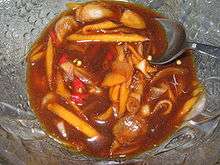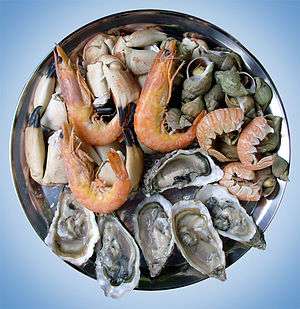Ngapi
Ngapi (Burmese: ငပိ or ငါးပိ [ŋəpḭ], lit. "pressed fish"), formerly also spelled ngapee,[1] nga-pee,[2] and gnapee,[3] is a generic term for pungent pastes made of either fish or shrimp in Burmese cuisine. Ngapi is usually made by fermenting fish or shrimp that is salted and ground then sun dried. Many variations exist. Ngapi is a generic term which applies only to the content. Like cheese, it can be distinguished based on main ingredient and regional origin. Ngapi can be distinguished from the type of fish used to make it. Ngapi can come from whole fish (such as ngapi kaung), from small fish (mhyin ngapi) or from prawns. Ngapi is a main ingredient of Lower Burmese cooking and is used as a condiment or additive in most dishes. Raw ngapi is not intended for direct consumption.
In other parts of Southeast Asia, a Malay form of the sauce known as balachong or balachaung is more popular.
Uses
Ngapi is a main ingredient of Lower Burmese cuisine from maritime coastal provinces in the west and the south. (It is not a main ingredient in traditional Upper Burmese (Burman, Shan, etc.) cuisines, although improved transportation in the modern era has helped increase ngapi's popularity in Upper Myanmar.) It is used in a wide array of dishes and is eaten in myriad ways: it can be eaten on its own, such as baked or roasted ngapi, as a watery preparation called ngapi yay (ငပိရည်), as a salad, as a pounded mixture with chili, or fried like balachong. It is also used as a soup base and in main dishes.
Variations
Regional variants
- Rakhine Ngapi (ရခိုင်ငပိ) - The ngapi of Rakhine State contains very little salt or none at all. It mainly uses marine fish, in light of the Arakanese being a seafaring people. Rakhine ngapi is used as a soup base for the Rakhine signature "national" dish, Mont Di (မုန့်တီ). Like other ngapi, it is widely used in cooking.
- In the Ayeyarwady and Tanintharyi divisions, the majority of ngapi is produced from freshwater fish. Ngapi usually contain a lot of added salt. This form of ngapi is more widely available in Myanmar and the Burmese population is more accustomed to the saltier ngapi than the Rakhine version. The ngapi from Myeik is very well known and is saltier than those from the region.
Other ngapi dishes
The versatility of ngapi is reflected in the colourful mosaic the people of Myanmar have developed to consume ngapi.
- Ngapi daung (ငပိထောင်း, pulverized ngapi) - the ngapi is baked or roasted in a frying pan without oil. Depending on the region and family preference, the ngapi is put in a stone mortar and is pounded with garlic and red or green chili.
- Ngapi yay (ငပိရည်, runny ngapi) -an essential part of Karen cuisine. In the S'gaw Karen language, this is known as "nya-u-htee". The ngapi (either fish or shrimp, but mostly whole fish ngapi is used) is boiled with onions, tomato, garlic, pepper and other spices. The result is a greenish-grey broth-like sauce, which makes its way to every Burmese dining table. Fresh, raw or blanched vegetables and fruits (such as mint, cabbage, tomatoes, green mangoes, green apples, olives, chilli, onions and garlic) are dipped into the ngapi yay and eaten. Sometimes, in less affluent families, ngapi yay forms the main dish, and also the main source of protein.
- Ngapi thoke (ငပိသုပ်, ngapi salad) - a salad (a thoke) made with ngapi diluted in lime or lemon juice and mixed with chopped onions and chili.
- Ngapi gyet (ငပိချက်, cooked ngapi) - ngapi cooked with oil and depending on the seasonal availability of fruits and vegetables, such as tomato, mango, chili, mayanthee (Marian plum), tamarind, etc.
- Ngapi kyeik (ငပိကြိတ်, ground ngapi) - a Rakhine condiment where baked rakhine ngapi is mixed with large green chili and garlic. It is also called Ngayote kyeik (ground chili)
- Ngapi gaung (ငပိကောင်, whole ngapi fish) - a type of relatively dry fermented salted fish usually gutted with the head on. Usually deep fried and served with fried crushed dried red chillies and crush garlic.
- Pè ngapi (ပဲငပိ), from the highland Shan States, ngapi is made instead from fermented soy beans also called pè bohk. Although lacking fish or prawn products, it is called ngapi. Pè ngapi is used as both a flavoring and a condiment in Shan and Burmese cuisine. It may also be used to make a curry.
- Ngapi kyaw (ငပိကြော်; also ngapi gyaw, fried ngapi), various types of ngapi that are fried with a wide variety of ingredients, mainly shredded shrimp flakes, onions, garlic and chili. The texture can range from jam-like to flossy (balachong), and the flavour varies depending on an individual household, restaurant or monastery. Ngapi gyaw is almost always present in ahlus (alms giving ceremonies) in Burmese monasteries. Some 'ngapi kyaw' may not contain ngapi at all.
Nutrition
As ngapi is made from fish, shrimp or beans, it is a source of protein. The ngapi made from marine fish and prawns also provide a source of iodine (which is abundant in all seafood): this may possibly be beneficial for those inland consumers whose diet may be iodine-deficient and who do not have access to iodized salt. Due to the high salt content which goes into the preparation, ngapi, like all salt-rich foods, should be consumed in moderation in patients with salt-sensitive hypertension.
See also
- Cuisine of Burma
- Shrimp paste
- Prahok, Cambodian fish paste
- Bagoong, Filipino fish paste
References
- ↑ "Burmah", Encyclopædia Britannica 9th ed., Vol. IV, 1876, p. 552.
- ↑ Titcomb, J.H. (1880), Personal Recollections of British Burma and Its Church Mission Work in 1878–79, London: Society for the Propogation of the Gospel in Foreign Parts, Ch. vii.
- ↑ "ngapi, n.", Oxford English Dictionary, 3rd ed., Oxford: Oxford University Press, 2003.

